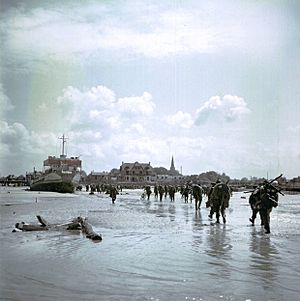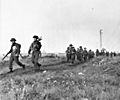Juno Beach facts for kids
Quick facts for kids Juno Beach |
|||||||
|---|---|---|---|---|---|---|---|
| Part of the Normandy landings and the Battle for Caen | |||||||
 Canadian soldiers landing at Juno on the outskirts of Bernières. |
|||||||
|
|||||||
| Belligerents | |||||||
|
|||||||
| Commanders and leaders | |||||||
| Units involved | |||||||
| Strength | |||||||
| 1 Infantry Division 1 Armoured Brigade 1 Commando Battalion |
Elements of 1 Infantry Division | ||||||
| Casualties and losses | |||||||
| 340 dead 574 wounded 47 captured |
Unknown | ||||||
Juno Beach was one of five main landing areas during the Normandy landings on June 6, 1944. This huge invasion helped the Allied forces take back German-controlled France during World War II. Juno Beach was located between two British landing spots, Gold and Sword. It stretched from the village of Courseulles to Saint-Aubin-sur-Mer.
The main job of capturing Juno Beach was given to the Canadian Army. They received help from the Royal Canadian Navy and the British Royal Navy. Other Allied navies, like those from Free France and Norway, also provided support.
Contents
The Mission at Juno Beach
The main goals for the 3rd Canadian Infantry Division on D-Day were clear. They needed to cut the main road between Caen and Bayeux. They also had to capture the Carpiquet airport, which was west of Caen. Finally, they aimed to connect with the British forces on the beaches next to them.
German Defenses
The Germans had strong defenses along Juno Beach. Two battalions of the German 716th Infantry Division were defending the area. They also had parts of the 21st Panzer Division ready as backup near Caen.
The Invasion Plan
The plan for Juno Beach involved two brigades of the 3rd Canadian Division. They were to land on two specific beach areas called Mike and Nan. These areas included the towns of Courseulles, Bernières, and Saint-Aubin.
Before the soldiers landed, ships and planes would bomb the German defenses. This was meant to weaken them and destroy strong points along the coast. Special armoured tanks from the 2nd Canadian Armoured Brigade would provide close support. Other special vehicles from the British 79th Armoured Division would also help.
Once the landing zones were safe, more Canadian troops would come ashore. The 9th Canadian Infantry Brigade would move further inland. Royal Marine commandos would try to meet up with the British 3rd Infantry Division on Sword Beach. The 7th Canadian Infantry Brigade would connect with the British 50th Infantry Division on Gold Beach. By the end of D-Day, the 3rd Canadian Division hoped to capture Carpiquet Airfield. They also aimed to reach the railway line between Caen and Bayeux.
The Landings and Push Inland
The landings at Juno Beach faced very strong resistance from the German 716th Division. The bombings before the invasion were not as effective as hoped. Also, bad weather caused the first wave of landings to be delayed until 7:35 AM.
Some companies of soldiers, especially from the Royal Winnipeg Rifles and The Queen's Own Rifles of Canada, suffered many casualties right away. But with many soldiers, strong artillery support, and tanks, most of the German defenses were cleared within two hours. More Canadian troops and Royal Marines started landing by 8:30 AM. The 9th Brigade began landing later, around 11:40 AM.
Moving Further Inland
Pushing inland towards Carpiquet and the Caen–Bayeux railway line had mixed results. So many soldiers and vehicles on the beaches caused long delays. This slowed down the attacks moving south.
The 7th Brigade met strong resistance at first. But they pushed south and linked up with the British 50th Division at Creully. The 8th Brigade also faced heavy fighting from a German battalion at Tailleville. The 9th Brigade moved towards Carpiquet in the early evening. However, strong German resistance in Saint-Aubin stopped the Royal Marines from connecting with the British 3rd Division on Sword Beach.
By 9:00 PM, all operations on the Anglo-Canadian front were ordered to stop. Despite the challenges, The Queen's Own Rifles of Canada had reached their D-Day goal. The 3rd Canadian Infantry Division had pushed further inland than any other Allied landing force on D-Day.
Images for kids
-
HMS Lawford, one of several Captain-class frigates converted to act as a headquarters ship for the Normandy landings, note the extended superstructure (to accommodate the Staff Officers) and additional smaller mainmast to support the extra aerials. On 8 June 1944, whilst operating off Juno, she was hit by enemy fire during an air attack and sunk.
-
Field Marshal Erwin Rommel inspecting Atlantic Wall defenses, April 1944
-
The cruiser HMS Belfast bombarding Juno on D-Day
-
The "Canada House", on Juno Beach, Bernières-sur-Mer, during the 76th anniversary of the D-Day landings.
See also
 In Spanish: Playa de Juno para niños
In Spanish: Playa de Juno para niños













